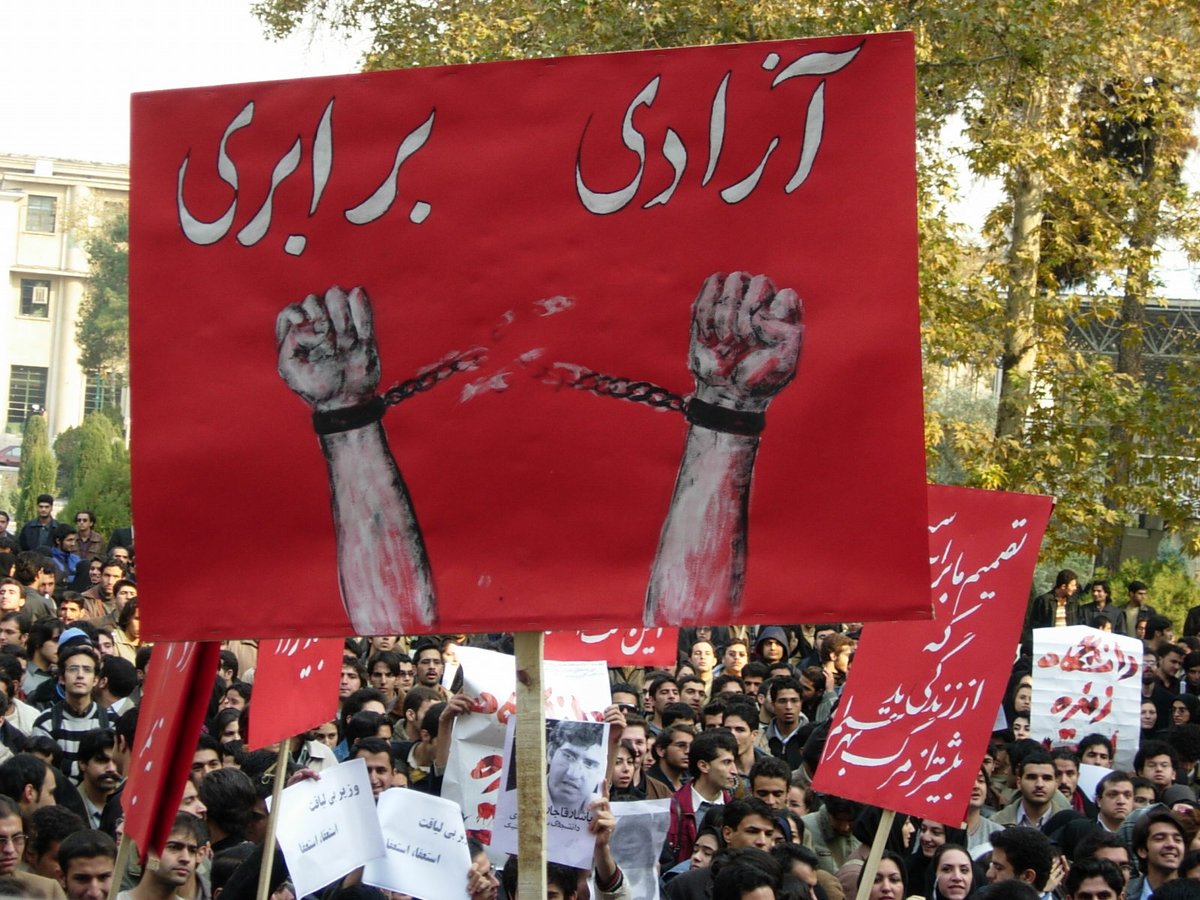The 4 December 2007 (13 Azar 1386) protest rally to commemorate national Student Day (16 Azar) on the campus of the University of Tehran marked the last public manifestation of the leftist student movement known as Students for Freedom and Equality (aka DAB, acronym for Daneshjuyan-e Azadikhah va Barabaritalab; literally, “Freedom-Seeking and Equality-Demanding Students”).
Although leftist activists have had a significant presence in some universities since the early 2000, the announcement of the existence of Students for Freedom and Equality took place in 2006. During the June 2006 student protests, a group of leftist students issued a statement entitled “University is not a barracks” announcing the existence of an organization called Students for Freedom and Equality.
Non-Islamic organizations are not allowed to operate in universities, according to the approvals of the Supreme Council of the Cultural Revolution. Students for Freedom and Equality, both before and after the Student Day were not an “organization” in the general sense, but consisted of a group of leftist students organized around a variety of student and political activities.

Iranian state security effectively crushed this student movement by arresting its key activists, thus terminating, for the time being, the growing influence of the first generation of “homegrown” and organized leftist students who had come of age after the vast purges of the leftist activists of various communist, socialist, social-democratic tendencies and groups (as well as others) of the previous generation, during the 1980s— those who had participated in the overthrow of the shah and the 1979 Revolution and thus had a living memory of revolutionary action and the Iranian Left’s concerns, issues, and activities before 1979 and also within the first few years after the Revolution.
Students for Freedom and Equality (henceforth SFE) generally owes its emergence to the limited social and political liberalization that took place following the rise of the Reform movement to government in 1997, which in effect ended the state monopoly over student organization on Iranian campuses. The SFE’s activism, despite the group’s conclusive demise, effectively nullified the state propaganda about the death of the Left and showed that the postwar “reconstruction period” and the country’s concomitant neoliberal and privatization policies, which have been breeding staggering inequalities and massive impoverishment of the middle class and lower sectors of society ever since, were to be met by resistance from the voices of social justice.
Although short-lived, the SFE stands at a curious conjunction in the history of political development in general and the Iranian Left in particular. It proves that the Left will return to civil society activism every time state control over civil society is somewhat relaxed. This observation leads to another: the traditional concerns and advocacy of the Left for social justice and democratic participation have been simmering within the youth who came of age in the Reform period (1997– 2005). This point is sociologically significant: many hold the view of Iranian leftists as primarily party affiliates and members with known ideological inclinations.
But the SFE indicates that the concerns of the Left have been socialized underneath the proverbial skin of society and within the existing state-controlled institutions, in this case universities, and these concerns were ready to surface under particular conditions. Moreover, for the most part, the SFE was a democratic student union consisting of the various, even diverging, shades of Marxism. It held together party-minded activists, those interested in scholarly leftism, and culturally oriented individuals while focusing on the particular concerns of students for freedom of expression and against the growing inequalities in Iran.
Although it might be argued that the democratic aspect of the SFE was a response to necessity, we nevertheless should call the SFE’s democratic attitude “frontal” (following Mostafa Sho‘aiyan), which refers to a group that consists of different ideological and political tendencies, instead of imposing a strict ideological and political guidelines to which all members are required to adhere. This is, by and large, also different from their leftists predecessors, with the notable exception of Confederation of Iranian Students-National Union (CISNU).
https://doi.org/10.1080/00210862.2020.1836952
Publication Date: 2021
Publication Name: Iranian Studies
The emergence and rapid but short-lived presence of Students for Freedom and Equality (SFE; in Persian: Daneshjuyan-e Azadikhah va Barabaritalab or DAB) across major Iranian campuses and their fateful 4 December 2007 protest rally on the campus of the University of Tehran speaks of the return of leftist student activism to Iranian campuses after almost two decades of absence or invisibility within the context of post-revolutionary Iran. SFE was an umbrella democratic organization: its activists came from a plurality of social and political backgrounds and adhered to diverse leftist ideas. But in the context of pro-Reform Movement student activism in Iranian post-secondary institutions in the late 1990s and in 2000s, for a short time the SFE tried to hegemonize student activism and challenge the various pro-government tendencies in university campuses. Before state repression forced the SFE out of operation in 2007, Students for Freedom and Equality brought to campuses candid discussions of social justice issues, critique of Iran’s neoliberal economic policies, and challenges to censorship and lack of freedom.










